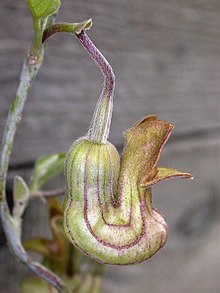Aristolochia californica
| Aristolochia californica | |
|---|---|
 |
|
| Scientific classification | |
| Kingdom: | Plantae |
| Clade: | Angiosperms |
| Clade: | Magnoliids |
| Order: | Piperales |
| Family: | Aristolochiaceae |
| Genus: | Aristolochia |
| Species: | A. californica |
| Binomial name | |
|
Aristolochia californica Torr |
|
Aristolochia californica, the California pipevine or California Dutchman's-pipe is a perennial woody vine of western North America.
The vine is endemic to northern California. It is native to the Sacramento Valley, northern Sierra Nevada foothills, San Francisco Bay Area, Northern Inner California Coast Ranges, southeastern Klamath Mountains.
The plant grows along riparian streambank areas, in chaparral, oak woodland, and mixed evergreen forest habitats. It is found below 700 metres (2,300 ft) in elevation.
Aristolochia californica is a deciduous vine. It grows from rhizomes, to a length usually around 5 feet (1.5 m), but can reach over 20 feet (6.1 m). The twining trunk can become quite thick in circumference at maturity.
It sends out new green heart-shaped leaves after it blooms. The bloom period is January through April.
The plant produces large green to pale brown curving pipe-shaped flowers, with purple veins and a yellow to red lining. The U shaped flowers produce winged capsular green fruits.
The California pipevine's flowers have a musty unpleasant odor which is attractive to tiny carrion-feeding insects. The insects crawl into the convoluted flowers and often become stuck and disoriented for some time, picking up pollen as they wander. Most eventually escape. The plant is not insectivorous, as was formerly thought. Fungus gnats (Mycetophilidae) may prove to be the effective pollinators. G.L. Stebbins suggested that pollination by deceit is presumed.
...
Wikipedia
